| All Artists: Robert Schumann, Silke Avenhaus Title: Schumann: Violin Sonatas 1-3 Members Wishing: 0 Total Copies: 0 Label: Cpo Records Release Date: 8/15/2000 Genre: Classical Styles: Chamber Music, Historical Periods, Classical (c.1770-1830), Instruments, Strings Number of Discs: 1 SwapaCD Credits: 1 UPC: 761203959723 |
Search - Robert Schumann, Silke Avenhaus :: Schumann: Violin Sonatas 1-3
 | Robert Schumann, Silke Avenhaus Schumann: Violin Sonatas 1-3 Genre: Classical
|
Larger Image |
CD Details |
CD ReviewsSuperiour playing Musicus | Oslo, Norway | 07/31/2006 (5 out of 5 stars) "This is without doubt the most attractive Schumann-CD in my shelf. To me Schumann doesn't impress unless the playing is truly superiour. This is the case here. It is rare to encounter a recording with so obviously inspired performances. Suddenly these pieces become interesting music. The readings of Faust & Avenhaus add nothing new the Schumann we know from before; the two girls undertakes something more difficult, playing the music much better than I guess anybody else. They believe in these works and makes me a believer too, in spite of my doubts about Schumann's consistency as a sonata-form composer. (I harbour no such doubts about his songs.) But of course, this CD is more than a matter of belief; it is a matter of insight; Faust & Avenhaus find the difficult narrow path between too loose a romantism and too strict a nerve. Natural, artless and fully convincing. Wonderful production too. I love this CD much more than I can explain in my poor English. My prefered Schumann and strongly recommended!" Schumann Brought To Life John Middleton | Auckland, NZ | 03/24/2006 (5 out of 5 stars) "How great to have all three sonatas on one CD, and with playing and sound quality like this, one need look no further. Schumann's contribution to this genre is not generally given its due. No. 1 gets a look in from time to time and is the shortest and best known of the three (being the one that fits most neatly into what is expected of a violin sonata). All the sonatas are late works, Nos. 1 and 2 written in 1851 and No. 3 in 1853, soon before his cataclysmic mental breakdown. I am tired of hearing the overstated view that Schumann's later oeuvre is tarnished or flawed by his failing mental powers. Ok sure - we all know he went nuts! But I truly believe that somehow his musical process was not adversely affected by this. In fact his creativity may even have been ignited by it. Schumann could compose intensely with his full powers and it was only later, after he finished, that he tended to collapse emotionally and need long periods to recover. In the hands of these two inspiring musicians these sonatas are shown to be important and wonderful works of Schumann's later years. No. 2 in particular comes across as vital and touching. In the last movement Faust's rhythmic exuberance makes light of the odd awkward passage and makes a feature of them instead! No. 3 is the least popular and known of the three and can be less convincing or gripping than the first two. Not so here. Note especially the unusually virtuosic (for Schumann) violin passage in the final movement and the joy with which it is devoured." Loved it! John Middleton | 06/19/2001 (5 out of 5 stars) "Delicious work by an up-and-coming performer. Isabelle Faust gives a wonderfully nuanced and sensitive rendering of these pieces, and the recording itself is meticulous. If you are not already won over by the radiant smile with which Ms. Faust greets you from the back of the liner notes, surely her playing will do the trick in short order. Silke Avenhaus adds steady accompaniment."
|

 Track Listings (11) - Disc #1
Track Listings (11) - Disc #1